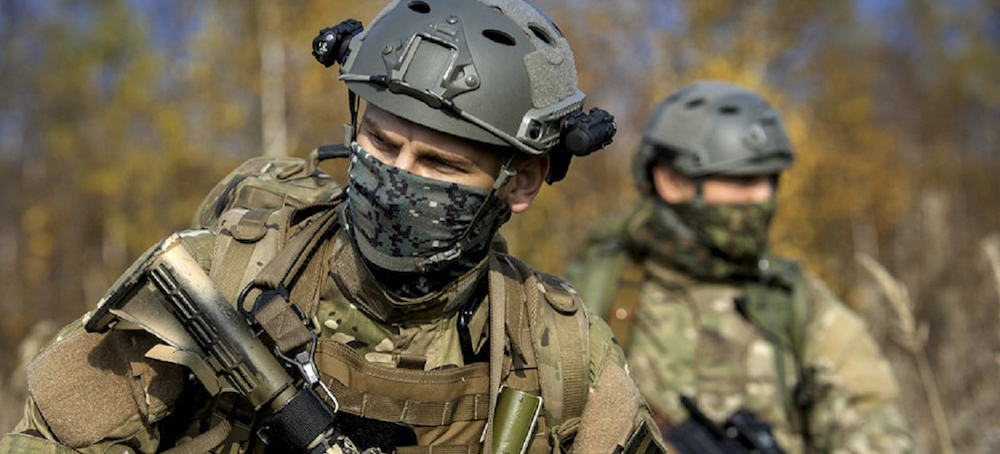Why Russian Troops Are Suddenly Able to Advance Toward Kharkiv
Max Boot The Washington Post Russian soldiers in Ukraine. (photo: Creative Commons)
Russian soldiers in Ukraine. (photo: Creative Commons)
Washington and Kyiv have both made mistakes — and Moscow is taking advantage.
Roughly five Russian battalions have managed to advance nearly five miles into Ukraine in just a few days, capturing a number of villages and sending Ukrainian defenders reeling in what might be the fastest Russian advance since the start of the war in February 2022. Lt. Gen. Kyrylo Budanov, head of Ukrainian military intelligence, described the situation to the New York Times on Monday as “on the edge” and moving “toward critical.”
If the Russians continue to advance, they could once again get within artillery range of Kharkiv, Ukraine’s second-largest city. I visited Kharkiv in March and saw the destruction Russian artillery wrought in 2022; the scars are still visible in the many abandoned high-rise apartment buildings on the city’s outskirts. It would be awful if there were a repeat of these Russian attacks. The worst-case scenario would be Kharkiv falling. That is still unlikely, but, to save the city, Ukraine is having to pull troops away from Donbas, making it easier for the Russians to advance in that region.
Why are the Russians having this sudden success? The explanation is a combination of Russian military prowess and Ukrainian and U.S. blunders.
The Russian forces have improved their combat performance since the early days of the war, when they could not seem to do anything right. They are adapting to battlefield conditions — for example, by using motorcycles to advance rapidly toward Ukrainian lines rather than relying on lumbering tanks and armored vehicles that can easily be picked off by Ukrainian drones and artillery. More significantly, they have been using heavy “glide bombs” to pulverize Ukrainian lines while their own electronic-warfare systems have been jamming Ukrainian drones and rockets.
Meanwhile, Ukraine’s armed forces have been severely handicapped by the long delay in approving U.S. aid. Ukrainian troops found themselves getting outgunned 10 to 1 in artillery ammunition, and their air-defense munitions have also been running dangerously low. The Wall Street Journal reports that “in the past six months, Ukraine intercepted around 46% of Russian missiles, compared with 73% in the preceding six-month period. … Last month the interception rate fell to 30% of missiles.” Ukraine’s inability to provide adequate air defense for front-line troops means that Russia has been able to use air power to a significant degree for the first time.
U.S. ammunition and weapons are now flowing, at long last, after Congress approved a $61 billion aid package, but it will take months to adequately supply all the Ukrainian forces. That creates a window of vulnerability the Russians are exploiting.
The Russians are also able to take advantage of the U.S. restrictions against using any U.S. weaponry to attack legitimate military targets in Russian territory. The Institute for the Study of War, a Washington think tank, blames the recent Russian advance “in large part” on these restrictions, which make it impossible for Ukraine forces to hit Russian troops massing to attack them only a few miles away. Britain has now lifted its similar restriction on using its weapons, but self-defeating U.S. limitations remain in place.
Ukraine’s government, unfortunately, has also inadvertently enabled the Russian advance by being so slow to expand its armed forces and to build fortifications. While Russia has greatly increased the number of its troops in and around Ukraine — to nearly 500,000 — Ukraine still has only about 200,000 troops at the front. Many of its units, fighting nonstop for more than two years, have been badly depleted.
The Ukrainian manpower shortfall has long been evident, but it was only last month that parliament finally passed a new mobilization law. Ukraine now plans to create 10 additional brigades, but recruitment, training and arming will take months — time Ukraine doesn’t have.
Ukraine has also been scandalously slow to fortify its borders and front lines. Last year’s Ukrainian counteroffensive stalled out because Russian minefields, trenches and barriers proved impregnable. The lack of commensurate Ukrainian fortifications is now enabling Russia’s advance. “There was no first line of defense,” one Ukrainian officer in the Kharkiv region complained to the BBC. “The Russians … just walked in, without any mined fields.”
In March, Ukrainian President Volodymyr Zelensky finally announced an initiative to build 1,200 miles of fortifications across three lines of defense. Those lines are now being constructed, but they should have been in place many months ago. This delay reflects Zelensky’s failure to do more to mobilize Ukrainian society for the war. Construction of luxury apartment buildings continues in Kyiv and western Ukraine even as the country fights a war for survival. All available construction workers and all their equipment should long ago have been sent to build fortifications.
The good news is that Ukraine should still have time to recover from these setbacks. The construction of new fortifications and the mobilization of more Ukrainian soldiers, combined with a massive inflow of U.S. weapons and ammunition, should stanch the Russian advance and stabilize the battle lines. It would greatly help if President Biden lifted the restrictions on using U.S. weapons to strike military targets inside Russia. But the situation is much more dire than it needs to be, in part because of foreseeable fumbles on the part of both Kyiv and Washington.



